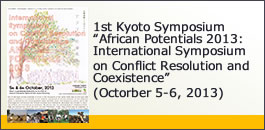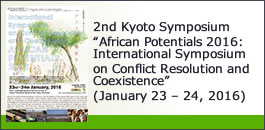Toward Conflict Resolution and Coexistence Realizing African Potentials
Itaru Ohta (Center for African Area Studies, Kyoto University)
Contemporary African societies face the challenge of repairing and reviving a social order that has been rent apart and exhausted by conflict. In Africa, particularly since the 1990s, conflicts of many kinds including large-scale civil wars and regional conflicts have been a frequent occurrence, generating vast numbers of refugees and internally displaced persons (IDPs). To address this situation, the international community has been involved in a number of ways including military intervention and support for the signing of cease-fire and peace agreements, cooperation in post-conflict institution-building, legal interventions such as through the International Criminal Court, and the provision of assistance through civil society organizations in the non-profit sector. These interventions have been largely motivated by Western ideological principles and values including human rights, democracy, and retributive legal justice. Moreover, these external interventions sometimes seem to have been informed by the idea that “because African societies lack mechanisms for conflict resolution, appropriate measures must be provided by the international community.” It is true that outside interventions have yielded certain results. However, such interventions have been less than effective in achieving social reconstruction and reconciliation between African neighbors scarred by conflict.
To overcome these difficulties, we must fundamentally revise our way of thinking by looking for inspiration from the lived experiences of African people. On the basis of this way of understanding the issues, we have set up a research project and held repeated discussions (Grant-in-Aid for Scientific Research [S]: “Comprehensive Area Studies on Coexistence and Conflict Resolution Realizing ‘African Potentials,’” 2011‒2015). In this project, we have taken the position that (1) people in Africa have put into practice the knowledge and institutions they have created and built up themselves (what we refer to as “African potentials”) for achieving conflict resolution and coexistence; and that (2) these can also be leveraged to promote conflict settlements and reconciliation between peoples, as well as to restore post-conflict society.
However, in this study, we do not consider African potentials as immutable or intrinsic entities, but understand them rather as being continuously generated, even today, in repeated collisions and fusions with the external influences of modern Western and Arabic-Islamic world views. Hence our research project, as it re-evaluates African potentials, seeks also to consider practical ways for these potentials to be leveraged in the interests of conflict resolution and coexistence in combination with a variety of extrinsic elements, including those introduced by the international community.
To that end, this research project has held study sessions for researchers brought together from across many fields, including international relations, international politics, peace building theory, economics, development studies, conservation biology, cultural anthropology, and ecological anthropology. On an annual basis, it has also held the African Conflict and Coexistence Forum in several African countries with the participation of local researchers and practitioners. Moreover, members of this project have continued to develop the ideas generated in these discussions by separating into four research units focusing on the themes of Politics and International Relations, Economy and Development, Livelihood and Environment, and Culture and Society. In today’s forum, I would like to welcome representatives from each of these four units and invite them to report on the outcomes of their studies so that we may deepen our understanding of African potentials.
Competitive State Formations and Transformation of Reconciliation in Northern Somalia
Mitsugi Endo (Graduate School of Arts and Sciences, University of Tokyo)
In Somalia, the first administration since the breakdown of the central government (in 1991 with the collapse of the Mohamed Siad Barre regime) was established in its capital of Mogadishu in November of 2012. Nevertheless, given the current situation it remains impossible to predict whether this new administration has the capacity to establish domestic legitimacy. In this sense, challenges remain that make it difficult to assert with any certainty that Somalia has been able to overcome the condition of being a “failed state.” Also, connected with the establishment of such new administrations, since 1991 and for over twenty years, meetings have been held inside Somalia calling for peace and reconciliation in various forms. Particularly in northern Somalia, local regimes have formed and appear to have governance structures that may help them to achieve some degree of stability.
Examples of regimes established as the result of “reconciliation” processes in northern Somalia include the regions that identify themselves as Somaliland in the northwest and Puntland in the northeast. However, in the “frontier” areas governed by these regimes, which formed as a result of various reconciliation processes that have been implemented in different periods, an extremely interesting species of political dynamism has been generated that has the potential to significantly impact Somaliland’s prospects for independence, as well as the problem of Somalia’s ability to create a stable long-term state. This phenomenon has also led to the destabilization of the frontier areas. In this report, I ask why this regional destabilization has taken place, and attempt to look for the answer to this question in competing state formations in northern Somalia and their consequences in transforming the functions of reconciliation.
Amidst processes of reconciliation and competition in northern Somalia, elders of the Dhulbahante clan living in the frontier area of Sool, located between the areas controlled by the two regimes, came to assume a major role in reconciliation initiatives and the establishment of governments, first in Somaliland at the beginning of the 1990s and then in Puntland in the late 1990s. However, traditional authorities among the Dhulbahante in the frontier areas were discredited as a consequence of this “politicization” and due to the ways in which they took part in initiatives to establish both of these regimes. This also reinforced a trend in which the clan’s customary capacity for reconciliation was being lost. Another result was encouraging destabilization in the frontier areas in a manner that not only promoted fragmentation among the Dhulbahante but also resurrected memories of the Dervishes as a resistance movement opposing colonial rule at the turn of the twentieth century. The resulting destabilization has further complicated efforts to determine the ownership of the frontier areas, to the point of potentially having a negative impact on state formation in Somalia in future.
In this report, I discuss the ambivalence of customary arbitration and reconciliation in Africa’s conflict areas. More specifically, whereas they are in some respects conducive to the formation of a certain order, in balance with the processes of modern state formation, they also possess another characteristic that results in this role undergoing a major transformation. By examining this question, I hope to play a part in this forum’s discussion by highlighting the possibilities and challenges inherent in customary mechanisms of reconciliation in the context of African potentials.
On Injustice and Discord: Conflicts over Economic Justice and Coexistence in Kenya
Motoki Takahashi (Graduate School of International Cooperation Studies, Kobe University)
From the perspective of economics, Collier et al.’s theory of “greed” and Stewart et al.’s theory of “horizontal inequalities” can be cited as two representative frameworks for the study of factors that lead to conflict. The former emphasizes greed by contrasting rational choice based on desire (greed) against emotions that are involved in identity (grievances), where the latter focuses on economic inequality between ethnic groups and other collectivities. Although perceptive, these theories are problematic in that they do not adequately capture the situational dependencies and interrelationships between factors involved in conflicts, nor do they discuss the intrinsic potential of African people for reconciliation and coexistence. Underlying this is the fact that these frameworks are inherently flawed in their inability to account for aspects of humanity that seek to suppress violence and encourage remorse, factors that overcome these impulses and impel human beings towards violence, and particularly the implications and roles of various forms of justice. The politicized ethnic conflicts that have convulsed Kenya’s Rift Valley region since the beginning of the 1990s have together resulted in thousands of deaths and generated refugees numbering at least in the hundreds of thousands. In connection with these conflicts, the numerous agencies of residents and stakeholders involved in a variety of forms of justice have come to be interwoven. In this report, I would like to explore potentials for coexistence in the context of the tensions between different kinds of justice for the two dimensions represented on the one hand by the wielders of political influence and the common people on the other.
One sequence of conflicts is held to have accompanied the reintroduction of the multi-party system, starting with raids by indigenous ethnic groups such as the Kalenjin people who attacked the Kikuyu and other settler groups, which resulted in counterattacks, and spurred a repetitive cycle of violent retribution. In this case, there have been attempts to justify the raids using the “rationale” that the original inhabitants possess the lands of the Rift Valley and were entitled to expel outsiders such as the Kikuyu. On the other hand, in the shadows of these conflicts, it was rumored that large-scale and illegal land acquisitions had taken place facilitated by former President Moi and a coterie of influential Kalenjin politicians close to him. From the late 1990s, this “land-grab” began to generate opposition forces among the Kalenjin against the Moi administration. The politicization of the land-grab issue along ethnic lines by wielders of political influence is something that was also apparent under the regime of Jomo Kenyatta, who is of Kikuyu ethnicity. However, in this case, the situation was further complicated by the fact that the anti-Moi movement was characterized on the one hand by its resistance to tribal groupings (including the Tugen and Keiyo) other than the Nandi people within the overarching Kalenjin ethnic group, on the other hand, it condemned the violence and injustice of the Moi regime in consideration of the rights of non-Kalenjin settlers. Whereas the former was similar to the “rationale” used to justify the raids, the latter carried the potential to lead to the construction of a justice system that transcended ethnic differences.
The post-electoral violence that began in 2007 has undermined the prospects for a new justice system, and subsequent political activities also seem to have deepened apparent tribalism. However, when we look at the attitudes and behavior of the general population, the outlines of a more complex form of justice begin to stand out. In the villages where raids took place, Kikuyu continue to coexist with Nandi, while mental illness has begun to develop among those Kalenjin who are believed to have taken part in the raids, allegedly with some cases of apparent suicide. Conflict prevention activities have been implemented in local communities, and members of different ethnic groups have participated in the creation of a movement among residents’ associations aimed at reconciliation and development. According to the results of an awareness survey conducted by reporters, most residents responded that they believed national politicians have a responsibility to support not to individual ethnic groups but to the citizenry as a whole, and responded that they would be willing to make a financial contribution to support their fellow Kenyans facing hardships. Even among the grassroots, there remains a lurking danger for national level conflicts to once again incite the exclusionary “rationale.” However, from people’s attitudes and behaviors in the wake of the post-electoral violence, it is also clearly apparent that people’s hearts and minds continue to be revived by the ongoing ebb and flow of a desire for coexistence and an understanding of justice that will transcend the bounds of ethnicity.
Current Status of Conflicts over Natural Resource Management in Sub-Saharan Africa
Gen Yamakoshi (Graduate School of Asian and African Area Studies, Kyoto University)
There have been some indications that struggles over natural resources now represent an important background consideration in several conflicts that have arisen in Sub-Saharan Africa. The issue of the development of fossil fuels and mineral resources has frequently been described as a pattern of suppression and exploitation of traditional rights and interests on the part of local communities and other actors entailing collusion or confrontation between international and state actors. However, such a pattern is found not only in relation to macroscopic and easily understood examples like subsoil resources, but also in relation to “skirmishes” over natural resources management at the level of more familiar landscapes such as croplands and pasture, as well as the use and conservation of wildlife. An illustration of this can be seen in discourses which hold that “by virtue of ecosystem services such as their complex biodiversity and carbon dioxide absorption, Africa’s jungles possess value on a global scale; their proper conservation and management by competent international institutions and personnel under the responsibility of state and international agencies is therefore necessary for humanity as a whole.”
The institutional history of nature conservation in Sub-Saharan Africa, which has focused on the establishment and maintenance of natural reserves, has its origins in the colonial era of the early twentieth century. Premised on the dismissal of any capacity for natural resources management on the part of the African people and grounded in views of nature and concepts of protection originating in Europe and America, top-down measures were taken on behalf of Western consumers to protect a natural environment that appealed to Western sensibilities, first by colonial governments and later by the new post-independence regimes. Evicted to make way for nature reserves and subjected to hunting and other regulations that limited their subsistence capacities, local residents opposed such “hard-faced” authority through resistance, disobedience, and feigned compliance. Nature conservation activities in Sub-Saharan Africa may thus be understood as being thoroughly extrinsic in character.
Much later, in a manner that reflected a paradigm shift that percolated through the philosophy of international development in the 1990s, new “participatory” approaches to conservation were proposed and put into practice with the aim of overcoming hardened conflicts such as those described above, and in recent years the outward appearance of nature conservation activities in Africa has undergone a major shift. By sharing the benefits of conservation practices with the local community, there have been reports of several successful examples of win-win relationships established between conservation agencies and local populations. While these have demonstrated the effectiveness of participatory approaches, it could also be argued this adoption of a “friendly face” has allowed the “hard face” of authority to become invisible. By promoting a form of community participation that “cannot say no,” the net of control by outside actors has been drawn tighter and a conflict that had previously been simpler has become segmented, so that varied interests throughout the region have erupted across the surface of the whole.
Recently, furthermore, as a result of participatory approaches emphasizing the return of revenue to local areas, revenue allocation and conservation efficacy have been framed in cut-and-dried and quantifiable terms. With the ensuing introduction of market mechanisms, a neoliberal move has become apparent in the switch in the delegation of environmental protection from a national agency to the private sector, and aspects of environmental protection are becoming even more diversified. In this presentation, based on discussions we have held in the Research Unit on Livelihood and Environment sponsored by the Grant-in-Aid for Scientific Research (S) for “Comprehensive Area Studies on Coexistence and Conflict Resolution Realizing ‘African Potentials’” (Project Leader Itaru OHTA), I shall outline the current state of conflictual aspects involving natural resource management in Sub-Saharan Africa while drawing on specific examples of environmental protection activities.
“African Potentials” as a Means of Conflict Resolution and Social Reconciliation
Motoji Matsuda (Graduate School of Letters, Kyoto University)
The future of African society, so “rosy” over a half century ago and coinciding with the Year of Africa, passed through an “age of despair” between the 1980s and 1990s. The continent has today re-emerged into the limelight as a supplier of resources to the global economy. Even so, contemporary African society continues to languish, scarred by conflict and wanton violence. Even now, conflicts still continue in many regions, including Mali, Central Africa, the Democratic Republic of the Congo (DRC), Sudan, South Sudan, and Somalia.
Despite outward appearances of growth and prosperity, the fabric of African society has been deeply rent by the conflicts and civil wars that have produced this wanton violence as well as a myriad of victims. Healing these social wounds, achieving reconciliation and coexistence between adversaries, and restoring justice to victims now represent the most urgent and important challenges facing African society. The method devised to address these challenges by civil society (the product of a Western European modernity that has continuously distorted African society for centuries, and whose prosperous history overlaps perfectly with the history of the trampling of African society) has been the punishment of perpetrators through universal laws and tribunals.
Nevertheless, African societies are attempting to create ways of addressing these challenges in a way that differs from these Western strategies. In fact, in parallel with the remedial measures implemented through the prosecution and punishment of responsible parties by special tribunals in domestic contexts or the International Criminal Court (ICC) at the global level, experimental approaches have appeared that are seeking to achieve post-conflict recovery, reconciliation and coexistence by focusing on “Africa-style” wisdom that is utterly distinct from the aforementioned remedial measures. The sorts of methods devised by African societies as “community wisdom” for achieving conflict resolution and coexistence are what we have conceptualized as “African potentials.” Since 2011 we have convened the African Potentials Forum in cooperation with local researchers, NGOs, and government officials in Nairobi, Harare, and Juba with the aim of refining these as resources for more practical application.
Contrary to the image of our vision for African potentials as amounting to re-activation of ritualized reconciliation or traditional systems of conflict resolution, the concept of African potentials should by no means be understood as unconditional admiration for or an exhortation to return to African tradition. African society is in the midst of major social changes brought about by rapidly advancing globalization and the influx of a heterogeneous mixture of ideas, systems, information, and materials. A wisdom that mixes and mingles with these represents a significant feature of African potentials. Therefore, the mere revival of traditional rituals of reconciliation as “events,” for example, bears no relation to African potentials. In its rejection of attempts to draw piecemeal on traditional and customary systems as techniques for conflict resolution, this could be called a kind of “de-technologization.” In addition, African models of conflict resolution will not always appear as closed. In combination with a “de-romanticization” in the sense of being distinguished from a stance of unconditional admiration or romantic fantasy, then, this open-minded “combinatory power” represents another important criterion for African potentials.
In this report, I would like to interrogate the above characteristics of African potentials while making reference to empirical examples that include community tribunals in Mozambique, the “Palaver” movement in South Africa, community policing and rituals of interfaith collaboration in Kenya, and traditional diviners in South Sudan. |
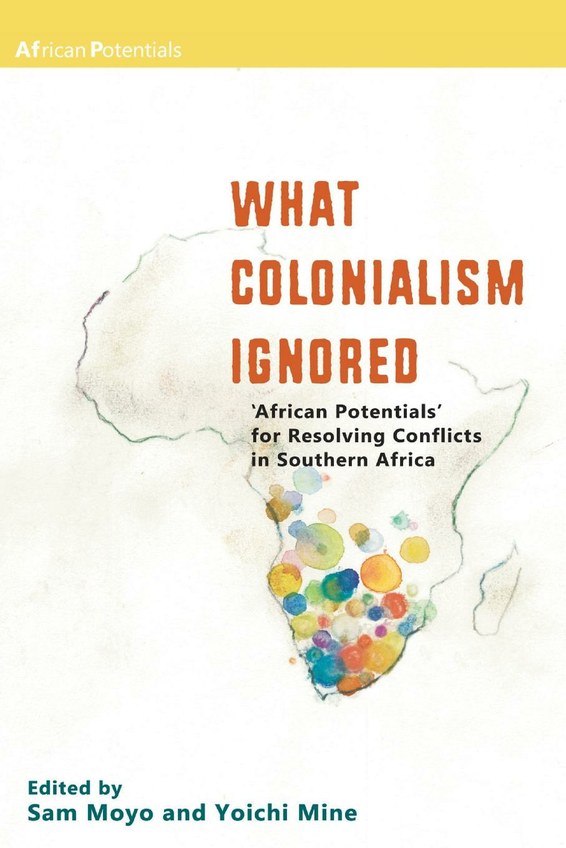
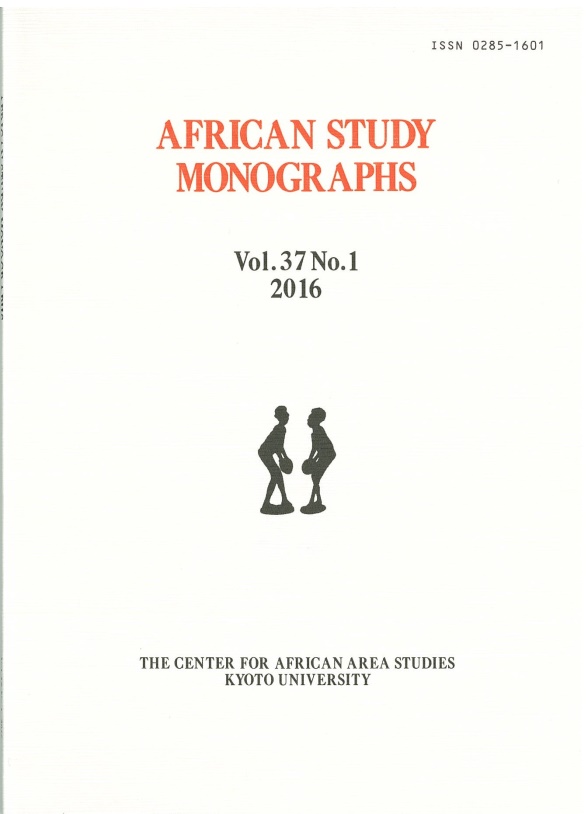
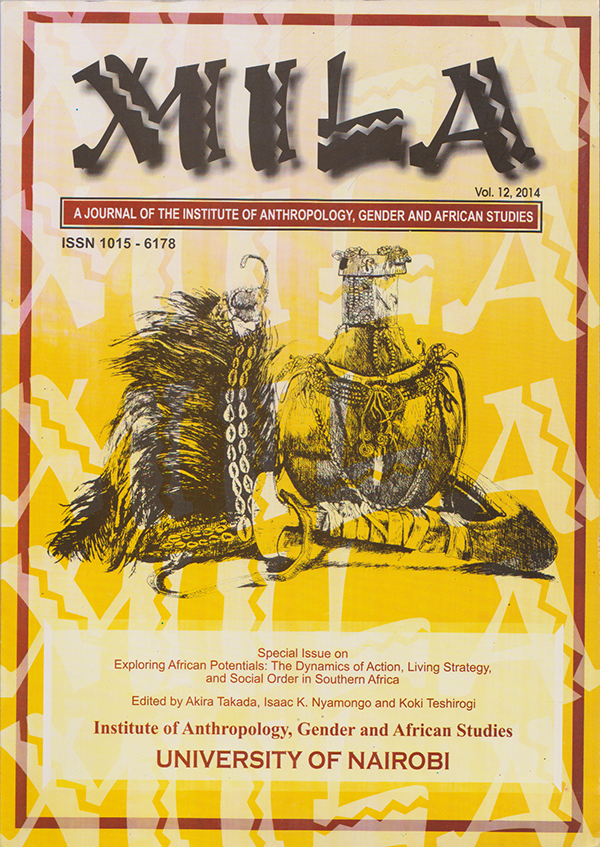 Exploring African Potentials, Mila Special Issue
Exploring African Potentials, Mila Special Issue